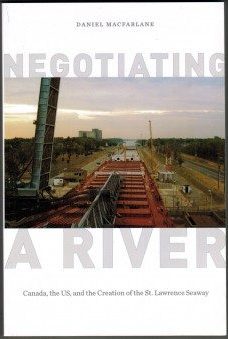Off the highway in Morrisburg, Ont. is a “historic site,” Upper Canada Village. The attraction is a fake.
“What was it really like to live and work in the 19th century?” the pamphlets ask. “Visit Upper Canada Village and travel back in time!” It is in fact a 1961 recreation of a genuine 1761 community destroyed to make way for the St. Lawrence Seaway. To actually travel back in time you must read Negotiating A River, the saga of a mega-project that created an engineering marvel and submerged a piece of the national fabric under 40 feet of water.
In a celebration of “faith in progress and technology,” writes author Daniel Macfarlane, seaway builders decided “it was worth erasing key parts of Canadian history, literally flooding the site of Crysler’s Farm from the War of 1812. The memorial there was relocated to a hill on the new shore beside Upper Canada Village.”
Macfarlane is a visiting Michigan State scholar at Carleton University’s School of Canadian Studies. He recounts authoritatively the decades of Canada-U.S. diplomatic wrangling that preceded actual construction of the seaway beginning in 1954.
The venture itself was phenomenal, “the tallest water staircase west of China, as the St. Lawrence Seaway Management Corporation once put it. It carries ships from Lake Superior 600 feet down to sea level and out the Atlantic. It is still something to see a Great Lakes freighter two city blocks long chug past the Thousand Islands.
From 1909 Canada and U.S. diplomats grappled over terms of what became a truly international venture. Americans had pushed for an all-Yankee route down the Hudson River. The first seaway treaty was rejected by the U.S. Senate in 1934 and never even put to a ratification vote in the House of Commons.
Negotiating A River is more than an engineering handbook or summary of diplomatic cables. Macfarlane skillfully recounts the most sorrowful chapter of seaway construction, the relocation of 9,100 people from their hometowns: “Although it was a national – even international – story at the time, it has been largely forgotten outside the St. Lawrence Valley.”
Ontario Premier Leslie Frost promised expropriation would be “decent and humanitarian” – well, as decent as expropriation can be. One official said residents of the lost villages “don’t have much to complain about.” They got to move to a new suburb with new shopping centres, didn’t they?
The toll of properties to be drowned for progress numbered 225 farms, 18 cemeteries, 531 homes and barns and old colonial towns like Farran’s Point and Aultsville, Moulinette and Dickinson’s Landing, founded circa 1783. “It was a disorienting experience for those who lived through the relocation,” Macfarlane writes. “For many, the best way to describe it might be traumatic.”
We are left with a seaway, the works of researchers like Macfarlane and the overpriced Upper Canada “reconstituted replica pioneer village,” he calls it. No plaque tells visitors the whole truth of what happened there.
By Holly Doan
Negotiating A River: Canada, the U.S., and the Creation of the St. Lawrence Seaway, by Daniel Macfarlane; University of British Columbia Press; 356 pages; ISBN 9780-7748-26440; $34.95






